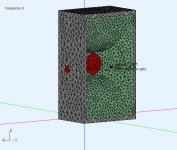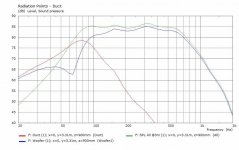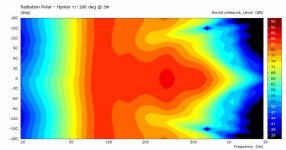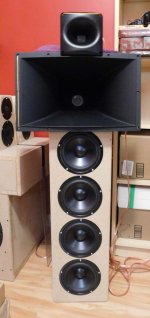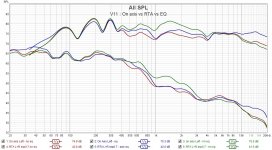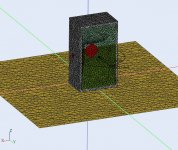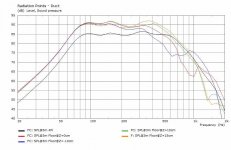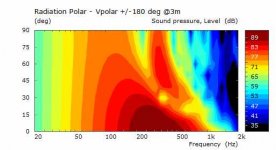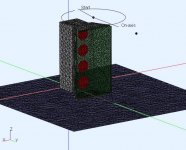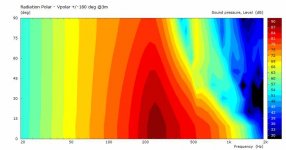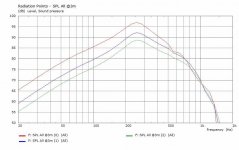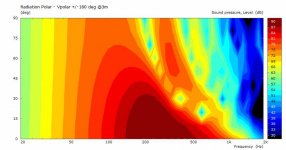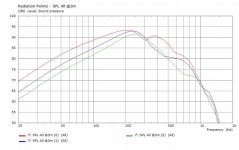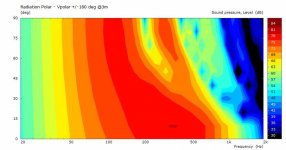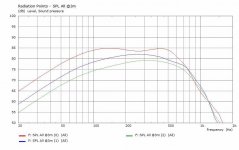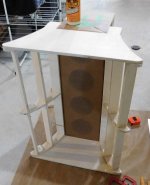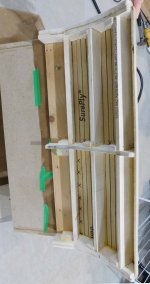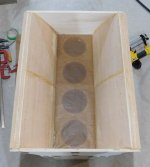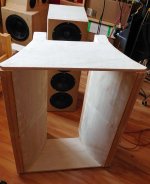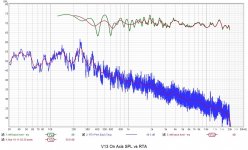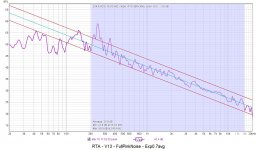Still tweaking this bass horn design trying to get reduced beam width and keep some LF performance. V13c is an expo300 ported horn with some EQ (and LR4-725Hz) to make it flattish.
.
.
Attachments
I was trying to tune the EQ for my V11 by either adjusting the axial response or adjusting via the room response. I usually EQ for a gated axial flat response (short <8ms). This speaker has a narrow 60deg MF+HF and a much wider LF. So it's a mismatched DI and sound power. It's the motivation to build a bass horn as a possible solution for 200-700Hz.
The sound power in the room includes both direct and indirect (reflections. absorption) and should be a function of the axial SPL and beamwidth. Using REW, the short term axial can be gated (30ms) and long term via RTA spectrum, pink noise, exp0.7 avg with some spacial averaging. The graph below has pairs [Axial, RTA] of curves, the top are short term (30ms) and the bottom are long term avg (10sec). The room looks like a low pass filter fc~300Hz, N=1. It sounds best (but still not balanced) just leaving it alone with flat axial EQ.
Red curves - no EQ
Blue curves - gated axial EQ
Green curves - EQ to smooth RTA
The sound power in the room includes both direct and indirect (reflections. absorption) and should be a function of the axial SPL and beamwidth. Using REW, the short term axial can be gated (30ms) and long term via RTA spectrum, pink noise, exp0.7 avg with some spacial averaging. The graph below has pairs [Axial, RTA] of curves, the top are short term (30ms) and the bottom are long term avg (10sec). The room looks like a low pass filter fc~300Hz, N=1. It sounds best (but still not balanced) just leaving it alone with flat axial EQ.
Red curves - no EQ
Blue curves - gated axial EQ
Green curves - EQ to smooth RTA
Attachments
The quad woofers provide reduced vertical beamwidth @xo and prevent floor bounce. So the same is required of the bass horn in 2Pi space (on the floor).
The ported expo horn (V13c) was simulated again in 2Pi space (floor) to check the performance. The model below shows a floor plane (for visual) indicating Z=0, the bottom of the horn cabinet. The floor model uses an IB@z=0, (but its transparent) that was moved up/down to intersect the horn to simulate a partially truncated/lifted horn to see the effect of the floor. The curves are simulation measurements @Y=300cm, Z=90cm (midrange horn height) with XO, driver motor, and EQ.
The reduction from 4Pi space (black curve) to the other 2Pi curves show the 6dB gain from reduced radiation space. Leaving the horn on the floor (Z=0cm, red) or lifting the horn (Z=-10cm) does not provide a clean response to 725Hz. The Z=10cm and Z=15cm curves (green, orange) would work, and imply an asymmetric horn, (partially truncated at the floor), or asymmetric driver placement. In either case the bass horn needs modification for 2Pi space.
The ported expo horn (V13c) was simulated again in 2Pi space (floor) to check the performance. The model below shows a floor plane (for visual) indicating Z=0, the bottom of the horn cabinet. The floor model uses an IB@z=0, (but its transparent) that was moved up/down to intersect the horn to simulate a partially truncated/lifted horn to see the effect of the floor. The curves are simulation measurements @Y=300cm, Z=90cm (midrange horn height) with XO, driver motor, and EQ.
The reduction from 4Pi space (black curve) to the other 2Pi curves show the 6dB gain from reduced radiation space. Leaving the horn on the floor (Z=0cm, red) or lifting the horn (Z=-10cm) does not provide a clean response to 725Hz. The Z=10cm and Z=15cm curves (green, orange) would work, and imply an asymmetric horn, (partially truncated at the floor), or asymmetric driver placement. In either case the bass horn needs modification for 2Pi space.
Attachments
A few more trials. The flare profiles were calculated using Hornresp and exported as CSV to create the models.
This is V13e using 2 x 8inch woofers ported, with Hypex T=0.7, 20cm deep horn. No EQ applied to see the change from 4Pi to 2Pi_IB to 2Pi_rug. I'm looking for ~2sr beamwidth at XO. It's not bad.
Pics#1-4 : 4Pi model and polars, SPL at 1,2,3m intervals at Z=90cm (midrange horn midheight)
Pics#5 : 2Pi model, using either IB or Rug
Pic#6 : 2Pi model SPL (1,2,3m) IB
Pic#7 : 2Pi model SPL (1,2,3m) Rug (dampling 0.5 fc=500Hz)
This is V13e using 2 x 8inch woofers ported, with Hypex T=0.7, 20cm deep horn. No EQ applied to see the change from 4Pi to 2Pi_IB to 2Pi_rug. I'm looking for ~2sr beamwidth at XO. It's not bad.
Pics#1-4 : 4Pi model and polars, SPL at 1,2,3m intervals at Z=90cm (midrange horn midheight)
Pics#5 : 2Pi model, using either IB or Rug
Pic#6 : 2Pi model SPL (1,2,3m) IB
Pic#7 : 2Pi model SPL (1,2,3m) Rug (dampling 0.5 fc=500Hz)
Attachments
-
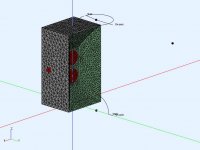 Dual8Woofer-Hypex-Model.jpg40.4 KB · Views: 100
Dual8Woofer-Hypex-Model.jpg40.4 KB · Views: 100 -
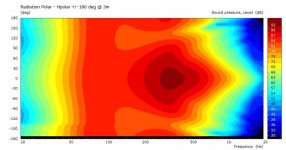 V13e-4Pi-Hpolar.jpg30.2 KB · Views: 94
V13e-4Pi-Hpolar.jpg30.2 KB · Views: 94 -
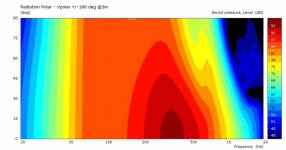 V13e-4Pi-Vpolar.jpg25.6 KB · Views: 100
V13e-4Pi-Vpolar.jpg25.6 KB · Views: 100 -
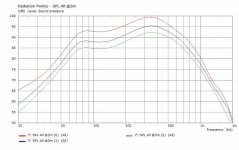 V13e_4pi-SPL@1-2-3m_z90cm.jpg35.8 KB · Views: 99
V13e_4pi-SPL@1-2-3m_z90cm.jpg35.8 KB · Views: 99 -
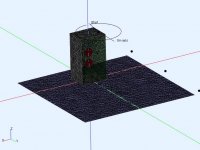 V13e-2piRug-Model.jpg44 KB · Views: 104
V13e-2piRug-Model.jpg44 KB · Views: 104 -
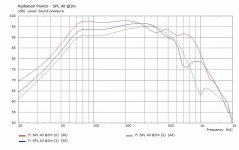 V13e-2piIB-SPL-1-2-3m@z90cm.jpg35.5 KB · Views: 99
V13e-2piIB-SPL-1-2-3m@z90cm.jpg35.5 KB · Views: 99 -
 V13e-2piRug-SPL-1-2-3m@z90cm.jpg35.8 KB · Views: 101
V13e-2piRug-SPL-1-2-3m@z90cm.jpg35.8 KB · Views: 101
Another trial V13f using the quad woofers I already have, and attaching a horn to the front to reduce the beamwidth. This is my preferred method so far and the one that I'll build. Just need to add wings. This will enable a V13 3way high DI horn speaker from 500Hz-16Khz (5/10 octaves).
Pics#1-4 : 4Pi model and polars, SPL at 1,2,3m intervals at Z=90cm (midrange horn midheight)
Pics#5 : 2Pi model, using either IB or Rug
Pic#6 : 2Pi model SPL (1,2,3m) IB
Pic#7 : 2Pi model SPL (1,2,3m) Rug (dampling 0.5 fc=500Hz)
Pics#1-4 : 4Pi model and polars, SPL at 1,2,3m intervals at Z=90cm (midrange horn midheight)
Pics#5 : 2Pi model, using either IB or Rug
Pic#6 : 2Pi model SPL (1,2,3m) IB
Pic#7 : 2Pi model SPL (1,2,3m) Rug (dampling 0.5 fc=500Hz)
Attachments
-
 V13f-4pi-Model.jpg38.7 KB · Views: 123
V13f-4pi-Model.jpg38.7 KB · Views: 123 -
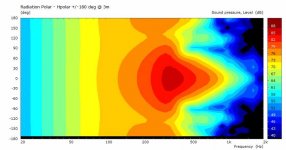 V13f-4pi-Hpolar.jpg29.6 KB · Views: 128
V13f-4pi-Hpolar.jpg29.6 KB · Views: 128 -
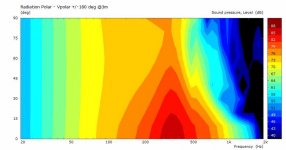 V13f-4pi-Vpolar.jpg25.7 KB · Views: 120
V13f-4pi-Vpolar.jpg25.7 KB · Views: 120 -
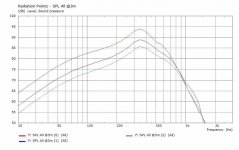 V13f-4pi-SPL-1-2-3m_z90cm.jpg35.2 KB · Views: 105
V13f-4pi-SPL-1-2-3m_z90cm.jpg35.2 KB · Views: 105 -
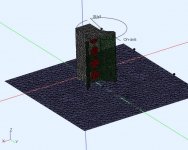 V13f-2piRug_Model.jpg52.1 KB · Views: 110
V13f-2piRug_Model.jpg52.1 KB · Views: 110 -
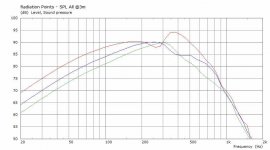 V13f-2piIB-SPL-1-2-3m.jpg31.8 KB · Views: 101
V13f-2piIB-SPL-1-2-3m.jpg31.8 KB · Views: 101 -
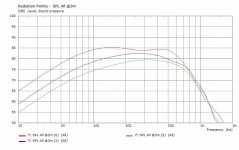 V13f-2piRug-SPL-1-2-3m.jpg34.1 KB · Views: 116
V13f-2piRug-SPL-1-2-3m.jpg34.1 KB · Views: 116
Don, how's it going with the first page idea to flip modules in and out to find the best drivers? 🙂
I am doing this my self and just compaired two soft dome mids. Visaton had to go.
I am doing this my self and just compaired two soft dome mids. Visaton had to go.
Don, iiuc the 2pi model results in a comb filter effect with the floor (IB) - right? This will be damped by using the rug with absorption?
Don, how's it going with the first page idea to flip modules in and out to find the best drivers? 🙂
I am doing this my self and just compaired two soft dome mids. Visaton had to go.
I'm not really trying to find the best driver, just good configurations, that I like, Often that means a different horn or driver to support a configuration change. It gives me something to model, build, and evaluate. Each revision attempts to fix something I didn't like. I really like my V10 speaker with cones and domes so it stopped evolving. Now, I think I'm close to a horn solution with the upcoming V13 speaker. I would like end up with 2 good configurations then I may swap drivers for more quality.
I do like the dome mids, what did you prefer over the Visaton?
Yes, that essentially what is happening. There is reinforcement (floor mirror) as well as an interference null that depends on the height, and wavelength. The rug damps some of the reflected higher freq to reduce the nulls. The woofer array provides the reinforcement, reduces vertical beamwidth (beams sooner) and minimizes the reflection. Adding the horn to reduce horizontal pattern is also effecting the floor reflection. These 3 pics are the vertical polars for 4pi, 2piIB, and 2piRug that show the interference null. I'm OK if any residual null is reduced and outside my vertical listening window so I also showed the SPL at (1m, 2m, 3m). I could probably also live with the IB (hardwood floor) SPL but the rug version is smoother.Don, iiuc the 2pi model results in a comb filter effect with the floor (IB) - right? This will be damped by using the rug with absorption?
Attachments
LPKM, old retro from the 80's.I'm not really trying to find the best driver, just good configurations, that I like, Often that means a different horn or driver to support a configuration change. It gives me something to model, build, and evaluate. Each revision attempts to fix something I didn't like. I really like my V10 speaker with cones and domes so it stopped evolving. Now, I think I'm close to a horn solution with the upcoming V13 speaker. I would like end up with 2 good configurations then I may swap drivers for more quality.
I do like the dome mids, what did you prefer over the Visaton?
Have you tested the Morel Classic MDM 55? it is something appealing with them, a small wave guide in the design also.
https://www.soundimports.eu/en/morel-mdm-55.html
Next up V13b.
The bass horn is a exponential (Fc~300Hz). The LF axial response has not been made flat in order to level out the sound power. It would likely need some LF EQ to sound correct
Could one use open baffle dipole instead of midbass horn to maintain directivity? Just an idea.
Looking at the width of your HF horn, I think the 550mm (22 inch) wide DDS bass/mid horn would be a great aesthetic and sonic solution? The horn/driver cabinet sits perfectly in a 550mm by 550mm box, you can vary the cabinet depth to give your required box volume. The horn adds 3.5dB evenly across the entire 60Hz to 1,200Hz band... Look at the attached polars... This gives you lots of options.... Even two per side 1,100mm tall / 550 wide will give you unlimited dynamics and a genuine flat response (with room DSP/ Eq) over 30Hz to 1,200Hz. I have heard this set up with twin Beyma 15 inch per side.... Wow!I was trying to tune the EQ for my V11 by either adjusting the axial response or adjusting via the room response. I usually EQ for a gated axial flat response (short <8ms). This speaker has a narrow 60deg MF+HF and a much wider LF. So it's a mismatched DI and sound power. It's the motivation to build a bass horn as a possible solution for 200-700Hz.
The sound power in the room includes both direct and indirect (reflections. absorption) and should be a function of the axial SPL and beamwidth. Using REW, the short term axial can be gated (30ms) and long term via RTA spectrum, pink noise, exp0.7 avg with some spacial averaging. The graph below has pairs [Axial, RTA] of curves, the top are short term (30ms) and the bottom are long term avg (10sec). The room looks like a low pass filter fc~300Hz, N=1. It sounds best (but still not balanced) just leaving it alone with flat axial EQ.
Red curves - no EQ
Blue curves - gated axial EQ
Green curves - EQ to smooth RTA
Attachments
The Morel looks good, but I have not tried it.LPKM, old retro from the 80's.
Have you tested the Morel Classic MDM 55? it is something appealing with them, a small wave guide in the design also.
https://www.soundimports.eu/en/morel-mdm-55.html
I also have a 3inch dome that's used in an older Paradigm 11se mk1 (80's speaker 🙂 ). Still like it's sound.
I think I would have to make the entire speaker dipole for that to work.Could one use open baffle dipole instead of midbass horn to maintain directivity? Just an idea.
I like the midrange horn enough to make the rest of the speaker accommodate it. I just need the bass horn to reduce the beamwidth to better match the horn's power response. I think I have a design now, so we'll have to see if it also sounds better.
Looking at the width of your HF horn, I think the 550mm (22 inch) wide DDS bass/mid horn would be a great aesthetic and sonic solution? The horn/driver cabinet sits perfectly in a 550mm by 550mm box, you can vary the cabinet depth to give your required box volume. The horn adds 3.5dB evenly across the entire 60Hz to 1,200Hz band... Look at the attached polars... This gives you lots of options.... Even two per side 1,100mm tall / 550 wide will give you unlimited dynamics and a genuine flat response (with room DSP/ Eq) over 30Hz to 1,200Hz. I have heard this set up with twin Beyma 15 inch per side.... Wow!
Thanks, The midrange (MF) horn is 450mmx280mm, beamwidth 60x40 and DI~10. I would like the match (or get closer) with the bass horn DI at 725Hz. I can do that vertically, but need a deeper horn to reduce the horizontal. I also want to keep the mini woofer array to deal with the floor bounce. No doubt the 2x15inch drivers would punch hard, but I would still have an issue with power balance to a narrow beamwidth horn.
Last bass horn model. V13g is deeper (210mm) and wider (500mm), Hypex T=0.7, Fc=116Hz, mouth perimeter is 1 lambda@116Hz. (calculated by Hornresp). The deeper horn better matches the midrange horn
These are the AKABAK simulations.
Pic 1 : model (shown on rug)
Pic 2,3 : 4Pi Vpolar and SPL at 1,2,3m z=90cm
Pic 4,5 : 2pi IB Vpolar and SPL
Pic 6,7 : 2Pi Rug and SPL
The wood has been bought, and templates have been made. Real measurements soon. 🙂
.
These are the AKABAK simulations.
Pic 1 : model (shown on rug)
Pic 2,3 : 4Pi Vpolar and SPL at 1,2,3m z=90cm
Pic 4,5 : 2pi IB Vpolar and SPL
Pic 6,7 : 2Pi Rug and SPL
The wood has been bought, and templates have been made. Real measurements soon. 🙂
.
Attachments
Don, that quadruppel bass pillar, are they all connected? What is the difference in sound, compaired with the more classical bass reflex build on page 1?
Cheers!
Cheers!
Each woofer has its own chamber, to reduce cavity dimensions and standing waves. They are wired as 2S-2P (I'd prefer 4P but 16R woofers are hard to find) with some FG fill mid chamber. Some time ago, I tried a single cavity and it was not as good (SPL smoothness, and THD). The sealed woofers have tighter and cleaner bass sound and they do not "boom" as much as the ported version. I have a subwoofer that is ported but it seems fine to me, probably because its crossed low and room tends to interfere more.
V13 bass horn build pics.
The horn was built on the woofer cabinet to ensure a tight fit. The wax paper covers the cabinet to prevents any glue seepage from sticking. The horn is modular and can be removed (6 screws attach it). It still requires finish sanding and some filler, but first I need to know if it fixes the power curve issue.
.
The horn was built on the woofer cabinet to ensure a tight fit. The wax paper covers the cabinet to prevents any glue seepage from sticking. The horn is modular and can be removed (6 screws attach it). It still requires finish sanding and some filler, but first I need to know if it fixes the power curve issue.
.
Attachments
Last edited:
.. and the measurements for V13.
The bass horn provides +9db gain at the XO (725Hz) so the sensitivity needs adjustment to make the whole speaker SPL flattish. The RTA no longer has the pronounced sag around the LF XO. It sounds much more balanced now. I just have to assemble the second horn 🙂
Pic#1 - 3 horn system V13
Pic#2 - gated axial SPL and RTA (full pink noise, exp0.7 avg)
Pic#3 - RTA (1/24 smooth) showing relatively constant slope
.
The bass horn provides +9db gain at the XO (725Hz) so the sensitivity needs adjustment to make the whole speaker SPL flattish. The RTA no longer has the pronounced sag around the LF XO. It sounds much more balanced now. I just have to assemble the second horn 🙂
Pic#1 - 3 horn system V13
Pic#2 - gated axial SPL and RTA (full pink noise, exp0.7 avg)
Pic#3 - RTA (1/24 smooth) showing relatively constant slope
.
Attachments
- Home
- Loudspeakers
- Multi-Way
- Modular active 3 way - work in progress
